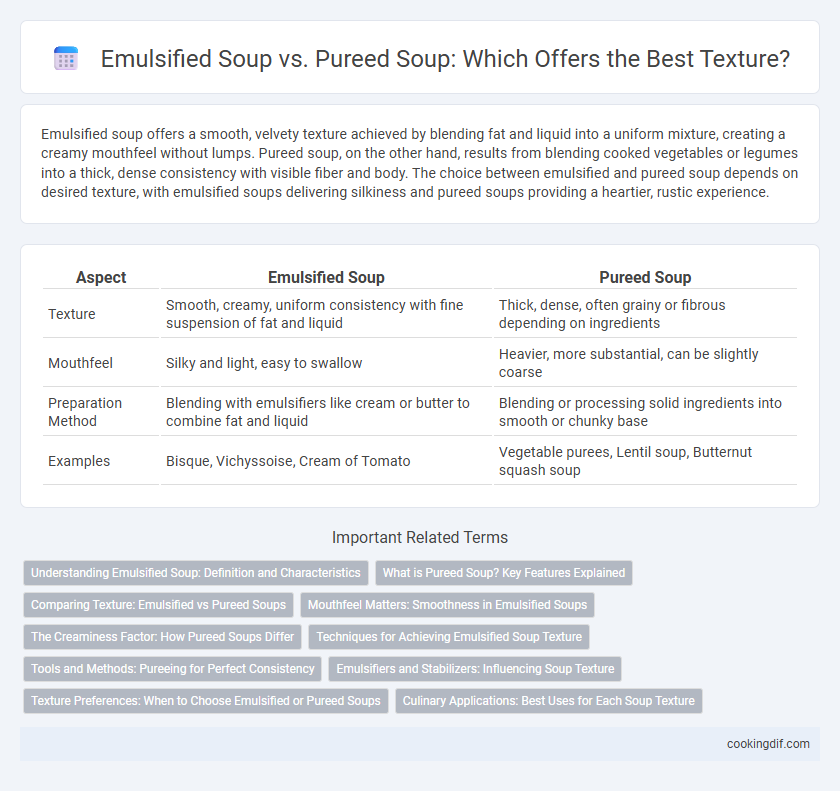Emulsified soup offers a smooth, velvety texture achieved by blending fat and liquid into a uniform mixture, creating a creamy mouthfeel without lumps. Pureed soup, on the other hand, results from blending cooked vegetables or legumes into a thick, dense consistency with visible fiber and body. The choice between emulsified and pureed soup depends on desired texture, with emulsified soups delivering silkiness and pureed soups providing a heartier, rustic experience.
Table of Comparison
| Aspect | Emulsified Soup | Pureed Soup |
|---|---|---|
| Texture | Smooth, creamy, uniform consistency with fine suspension of fat and liquid | Thick, dense, often grainy or fibrous depending on ingredients |
| Mouthfeel | Silky and light, easy to swallow | Heavier, more substantial, can be slightly coarse |
| Preparation Method | Blending with emulsifiers like cream or butter to combine fat and liquid | Blending or processing solid ingredients into smooth or chunky base |
| Examples | Bisque, Vichyssoise, Cream of Tomato | Vegetable purees, Lentil soup, Butternut squash soup |
Understanding Emulsified Soup: Definition and Characteristics
Emulsified soup is a smooth, creamy mixture achieved by blending oil or fat with water-based ingredients to create a stable, unified texture without separation. Unlike pureed soup, which involves blending cooked ingredients into a thick, dense consistency, emulsified soup relies on the emulsification process to produce a light, velvety mouthfeel. This technique enhances flavor integration while maintaining a fluid, cohesive texture that differentiates it from the heavier, more textured purees.
What is Pureed Soup? Key Features Explained
Pureed soup is a smooth, creamy blend created by cooking vegetables, legumes, or meats until tender and then blending them to a uniform consistency. Key features include a thick, velvety texture achieved without added emulsifiers, relying solely on natural ingredients for body and richness. Unlike emulsified soups that combine fats and liquids to create a stable mixture, pureed soups emphasize the natural flavors and smoothness of the ingredients.
Comparing Texture: Emulsified vs Pureed Soups
Emulsified soups have a smooth, velvety texture achieved by blending fat and liquid into a uniform mixture, creating a rich mouthfeel without visible chunks. Pureed soups, on the other hand, are thicker and denser because vegetables and other solids are blended into a cohesive, creamy mass, often retaining some fibrous structure. The choice between emulsified and pureed soup textures depends on the desired consistency and sensory experience, with emulsified soups offering lightness and pureed soups providing heartiness.
Mouthfeel Matters: Smoothness in Emulsified Soups
Emulsified soups offer a silky mouthfeel achieved by finely dispersing fat droplets throughout the liquid, creating a smooth, velvety texture that coats the palate evenly. Pureed soups, while thick and hearty, retain small food particles that contribute to a denser, more textured mouthfeel. The emulsification process enhances creaminess and smoothness, making emulsified soups ideal for a luxurious, refined dining experience.
The Creaminess Factor: How Pureed Soups Differ
Pureed soups achieve a smooth, velvety texture by blending cooked ingredients into a uniform consistency, enhancing the creaminess factor without adding dairy. Emulsified soups combine oil or fat with broth using emulsifiers to create a silky mouthfeel and richer texture, often resulting in a lighter but luxurious creaminess. The key difference lies in pureed soups relying on the natural starches and fibers of ingredients, while emulsified soups depend on the stability of fat droplets suspended in liquid.
Techniques for Achieving Emulsified Soup Texture
Emulsified soups achieve a smooth, velvety texture by carefully blending fat and liquid components to create a stable mixture, often using techniques such as whisking hot stock into cream or incorporating butter through gradual emulsification. Pureed soups rely on cooking vegetables or legumes until soft, then blending them thoroughly to form a thick, uniform consistency without the need to stabilize fat and liquid phases. Mastering temperature control and gradual mixing are essential techniques to prevent separation and achieve the silky texture characteristic of emulsified soups.
Tools and Methods: Pureeing for Perfect Consistency
Emulsified soup achieves a velvety texture by blending hot ingredients with fat using immersion blenders or food processors, creating a smooth, unified mixture. Pureed soup relies on tools like high-speed blenders or sieves to break down cooked vegetables and legumes into a thick, creamy consistency without separating liquids and solids. Mastering pureeing techniques ensures optimal texture, with gradual blending and straining methods enhancing soup uniformity and mouthfeel.
Emulsifiers and Stabilizers: Influencing Soup Texture
Emulsified soups rely on emulsifiers like lecithin or mustard to blend oil and water, creating a smooth and creamy texture without separation. These stabilizers enhance mouthfeel and prevent ingredient separation, resulting in a velvety consistency that distinguishes emulsified soups from pureed varieties. Pureed soups, while thick and smooth from blended solids such as vegetables or legumes, lack the same integrated oil-water structure, leading to a different texture profile.
Texture Preferences: When to Choose Emulsified or Pureed Soups
Emulsified soups offer a smooth, velvety texture achieved by blending fats and liquids into a uniform consistency, ideal for preserving a rich mouthfeel without the heaviness of purees. Pureed soups provide a thicker, creamier texture by blending cooked ingredients into a dense, comforting base, perfect for hearty preferences or when a substantial body is desired. Texture preferences dictate choosing emulsified soups for lighter, silkier experiences, while pureed soups suit those craving a robust, creamy texture.
Culinary Applications: Best Uses for Each Soup Texture
Emulsified soups feature a smooth, creamy texture achieved by blending fat and liquid, ideal for rich, velvety dishes like bisques and cream-based soups that require a luxurious mouthfeel. Pureed soups, made by blending cooked vegetables or legumes into a thick, hearty consistency, excel in rustic, nutritious recipes such as vegetable purees and bean soups that emphasize body and substance. Culinary applications favor emulsified soups for elegant presentations and delicate flavors, while pureed soups suit robust, filling meals that highlight wholesome ingredients.
Emulsified Soup vs Pureed Soup for texture Infographic

 cookingdif.com
cookingdif.com